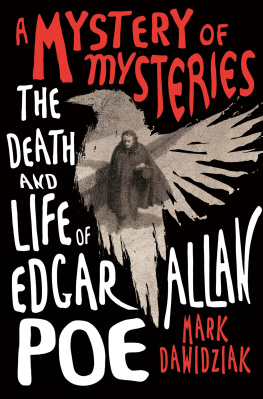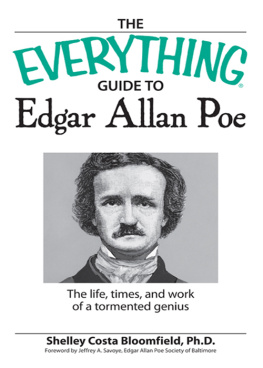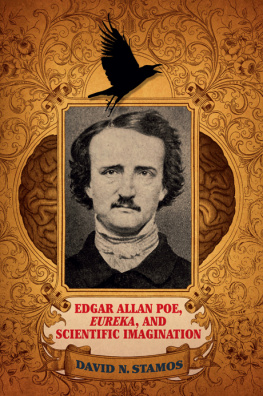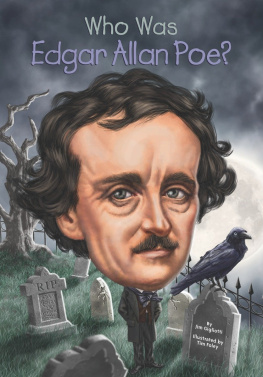
The author and publisher have provided this e-book to you for your personal use only. You may not make this e-book publicly available in any way. Copyright infringement is against the law. If you believe the copy of this e-book you are reading infringes on the authors copyright, please notify the publisher at: us.macmillanusa.com/piracy.
To Sara, with a love that is more than love,
and to our daughter, Becky, so gifted, loving, and brave much I marvel
To them both evermore
The breezethe breath of Godis still
And the mist upon the hill
Shadowyshadowyyet unbroken,
Is a symbol and a token
How it hangs upon the trees,
A mystery of mysteries!
FINAL STANZA OF SPIRITS OF THE DEAD BY EDGAR ALLAN POE
Letters, magazine articles, newspaper pieces, and books from the nineteenth century, as well as Poes stories, essays, and reviews, are quoted throughout this work. The original punctuation and spelling have been retained with no effort to make them conform with modern grammar and usage.
Thenin my childhoodin the dawn
Of a most stormy lifewas drawn
From evry depth of good and ill
The mystery that binds me still
FROM EDGAR ALLAN POES ALONE
Having completed just forty years of what was without question a most stormy life, Edgar Allan Poe took leave of this realm early Sunday morning, October 7, 1849. Nobody knows precisely why. Indeed, like so many aspects of his life, his death has been the topic of endless debate, conjecture, speculation, guessing, and second-guessing. Nobody can tell you with anything resembling certainty why, while traveling from Richmond to New York, he ended up in Baltimore. Nobody can tell you what happened to him during the missing days between his last sighting in Richmond on the evening of September 26 and his reappearance outside an Election Day polling place in Baltimore on the damp, chilly afternoon of October 3. Nobody has ever solved the identity of the person, Reynolds, for whom Poe supposedly called out for hours before he died at the Washington University Hospital of Baltimore. Nobody has ever produced conclusive evidence, or so much as a first cousin to it, regarding the cause of the delirium generally described as congestion of the brain, cerebral inflammation, or brain fever. Even the melodramatic and rather pat last words attributed to himLord help my poor soul!have been called into question. The source for that dying utterance is a shaky witness who trafficked in contradictory testimony, attending physician John J. Moran (who may or may not have been in attendance at the time of death). The one thing that can be said with absolute certainty is that Edgar Allan Poe died at the age of forty years, eight months, and change because he stopped drawing breath. Or, to put it somewhat more poetically, as he wrote in one of his poems, For Annie:
The danger is past,
And the lingering illness
Is over at last
And the fever called Living
Is conquered at last.
Poes death has become so much a part of his mystique that it is often the first topic broached by visitors to the major destination sites devoted to the writer: the Edgar Allan Poe House in Baltimore, where, in the early 1830s, he discovered both a family that accepted him and a gift for short fiction; the Edgar Allan Poe Museum in Richmond, the city where he did much of his growing up and where, in 1835, he launched his often-controversial career as an influential literary critic and magazine editor; the Edgar Allan Poe National Historic Site, the only one of his five Philadelphia residences from 183844 still standing; and the Edgar Allan Poe Cottage in the Bronx, his rented home from the spring of 1846 until his death. I would be a millionaire if I had a dime for every time Ive been asked how he died, said Steve Medeiros, a Poe scholar and former National Park Service ranger whose regular duties included greeting those who passed through the door of the Philadelphia house.
During an interview conducted for this book, Matthew Pearl, author of the acclaimed 2006 novel The Poe Shadow, observed, His biography doesnt really start where most biographies traditionally start, with his birth; it starts with his death. Is there a hint here of Poes observation that romance writers could learn from Chinese authors who had sense enough to begin their books at the end?
The ongoing fascination with his death is understandable. It is, after all, one of the great literary stage exits of all timeright up there with Molire, the actor-playwright who, suffering from pulmonary tuberculosis, overcame an onstage collapse and hemorrhage to finish a final performance before dying a few hours later in 1673, and Mark Twain, who correctly predicted that, having been born when Halleys Comet visited the Earth in 1835, he would die when it returned in 1910. Poes death, however, takes on added significance because it is undeniably one of the major factors keeping him alive as one of the most instantly recognizable writers of all time and the most-read American author around the world. Here, too, Twain is in the running, but Poe probably is better read while Twain is more frequently quoted (although often inaccurately). Poes death is not only a source of continuing fascination; it is also symbolic of what became his deeply entrenched literary identity. He died under haunting circumstances that reflect the two literary genres he took to new heights.
Poe might as well have been writing his own epitaph with the first line of his story The Assignation: Ill-fated and mysterious man!bewildered in the brilliancy of thine own imagination, and fallen in the flames of thine own youth! His death is a moment shrouded in horror. Poe died in a lingering, painful manner that would not have been out of place in one of his own incredibly influential terror tales. It is also a moment surrounded by mystery. It is, in fact, a double-barreled mystery. What was the cause of Poes death, and what happened to him during those missing days before he was found in great distress on the streets of Baltimore, wearing ill-fitting clothes that were not his own? Why did he look so disheveled, his hair unkempt, his face unwashed, and his eyes lusterless and vacant? Pale and alternately described as both cold to the touch and burning up with fever, Poe in his delirium held conversations with what resident physician Moran said were spectral and imaginary objects on the wall. Sound like the description of a character in one of his stories? It also sounds like a mystery worthy of Poes master detective (and the model for so many super sleuths to follow), C. Auguste Dupin. Here, to be sure, is both mystery and horror aplenty. The haunted writer and the father of the detective story leaves us with grim mysteries that have defeated every attempt to solve them, Medeiros said. Its almost as if a publicist stepped in and said, Hey, you know, the best thing for you to do for the career is to die under mysterious circumstances at forty.
It has been suggested that one reason Poe was drawn to the horror genre was an attraction to the American nineteenth-century death culture, which resulted in increasingly elaborate mourning rituals, grander and more extensive cemeteries, and heartrending songs and poems dwelling on grief and loss. Death most assuredly was a constant companion throughout Poes life. So perhaps its fitting that something of a death culture has developed around him. An astonishing number of theories have been pursued but never proven examining both the missing days and the cause of death. The long list of candidates for what carried him off includes binge drinking, rabies, murder, a brain tumor, encephalitis brought on by exposure, syphilis, suicide, heart disease, carbon monoxide poisoning from illuminating coal gas, and dementia caused by normal pressure hydrocephalus. A new answer seems to pull into the speculation station every couple of years. Hang around that station for any length of time and youre pretty certain to run into someone claiming he or she has solved the mystery of Poes deathunless, of course, that person is blocked out by someone claiming he or she just solved the identity of Jack the Ripper.
Next page









